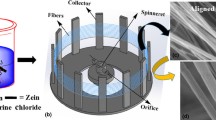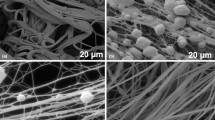Abstract
The aim of current study is to fabricate implantable curcumin embedded gelatin/polylactic acid/curcumin (GL/PLA/Cur) aligned fiber scaffolds by forcespinning®, which might have a potential application in drug delivery and cancer therapy. Fourier Transform Infrared Spectroscopy reveals the hydrogen bonding interactions between GL, PLA, and curcumin. In vitro curcumin drug release from GL/PLA/Cur fiber scaffolds is investigated and sustained release is observed over 15 days. Further, cell viability assay reveals that GL/PLA/Cur aligned fibers show excellent growth of human fibroblast cells. These results strongly suggest that the curcumin bearing GL/PLA/Cur composite fibers may show the potential application in cancer therapy, drug delivery, and wound dressing.






Similar content being viewed by others
References
B.B. Aggarwal, A. Kumar, and A.C. Bharti: Anticancer potential of curcumin: preclinical and clinical studies. Anticancer Res. 23, 363 (2003).
A. Goel, A.B. Kunnumakkara, and B.B. Aggarwal: Curcumin as ‘Curecumin’: from kitchen to clinic. Biochem. Pharmacol. 75, 787 (2008).
J. Merrell, S. McLaughlin, L. Tie, C. Laurencin, A. Chen, and L. Nair: Curcumin loaded poly (ε-Caprolactone) nanofibres: diabetic wound dressing with antioxidant and anti-inflammatory properties. Clin Exp Pharmacol Physiol. 36, 1149 (2009).
A. Abidi: Evaluation of efficacy of curcumin as an add-on therapy in patients of bronchial asthma. J. Clin. Diagnostic Res. 8, 19 (2014).
D.-W. Zhang, M. Fu, S.-H. Gao, and J.-L. Liu: Curcumin and diabetes: a systematic review. Evid. Based. Complement. Alternat. Med. 2013, 636053 (2013).
V.P. Kurup and C.S. Barrios: Immunomodulatory effects of curcumin in allergy. Mol. Nutr. Food Res. 52, 1031 (2008).
Y. Henrotin, F. Priem, and A. Mobasheri: Curcumin: a new paradigm and therapeutic opportunity for the treatment of osteoarthritis: curcumin for osteoarthritis management. Springerplus. 2, 1 (2013).
M.J. Mitchell and M.R. King: Curcumin and neurodegenerative diseases. 39, 1 (2014).
M.C. Ramírez-Tortosa, M.D. Mesa, M.C. Aguilera, J.L. Quiles, L. Baró, C.L. Ramirez-Tortosa, E. Martinez-Victoria, and A. Gil: Oral administration of a turmeric extract inhibits LDL oxidation and has hypocholesterolemic effects in rabbits with experimental atherosclerosis. Atherosclerosis. 147, 371 (1999).
V.K.L. Shanbhag: Curcumin in chronic lymphocytic leukemia - A review. Asian Pac. J. Trop. Biomed. 7, 505 (2017).
A. Greiner and J.H. Wendorff: Electrospinning: a fascinating method for the preparation of ultrathin fibers. Angew. Chemie - Int. Ed. 46, 5670 (2007).
J. Boateng, J. Mani, and F. Kianfar: Improving drug loading of mucosal solvent cast films using a combination of hydrophilic polymers with amoxicillin and paracetamol as model drugs. Biomed Res. Int. 2013, 1–8 (2013).
S. Parveen, R. Misra, and S.K. Sahoo: Nanoparticles: a boon to drug delivery, therapeutics, diagnostics and imaging. Nanomed. Nanotechnol. Biol. Med. 8, 147 (2012).
E. Thangaraju, N.T. Srinivasan, R. Kumar, P.K. Sehgal, and S. Rajiv: Fabrication of electrospun Poly L-lactide and Curcumin loaded Poly L-lactide nanofibers for drug delivery. Fibers Polym. 13, 823 (2012).
E.R. Kenawy, G.L. Bowlin, K. Mansfield, J. Layman, D.G. Simpson, E.H. Sanders, and G.E. Wnek: Release of tetracycline hydrochloride from electrospun poly(ethylene-co-vinylacetate), poly(lactic acid), and a blend. J. Control. Release 81, 57 (2002).
H. Jiang, D. Fang, B.S. Hsiao, B. Chu, and W. Chen: Optimization and characterization of dextran membranes prepared by electrospinning. Biomacromolecules 5, 326 (2004).
Y.J. Son, W.J. Kim, and H.S. Yoo: Therapeutic applications of electrospun nanofibers for drug delivery systems. Arch. Pharm. Res. 37, 69 (2014).
G. Guo, S. Fu, L. Zhou, H. Liang, M. Fan, F. Luo, Z. Qian, and Y. Wei: Preparation of curcumin loaded poly(ε-caprolactone)-poly(ethylene glycol)-poly(ε-caprolactone) nanofibers and their in vitro antitumor activity against Glioma 9L cells. Nanoscale 3, 3825 (2011).
M. Ranjbar-Mohammadi, and S.H. Bahrami: Electrospun curcumin loaded poly(ε-caprolactone)/gum tragacanth nanofibers for biomedical application. Int. J. Biol. Macromol. 84, 448 (2016).
M. Fallah, S.H. Bahrami, and M. Ranjbar-Mohammadi: Fabrication and characterization of PCL/gelatin/curcumin nanofibers and their antibacterial properties. J. Ind. Text. 46, 562 (2016).
X.Z. Sun, G.R. Williams, X.X. Hou, and L.M. Zhu: Electrospun curcumin-loaded fibers with potential biomedical applications. Carbohydr. Polym. 94, 147 (2013).
G. Perumal, S. Pappuru, D. Chakraborty, A. Maya Nandkumar, D.K. Chand, and M. Doble: Synthesis and characterization of curcumin loaded PLA—Hyperbranched polyglycerol electrospun blend for wound dressing applications. Mater. Sci. Eng. C 76, 1196 (2017).
R. Langer and D.A. Tirrell: Designing materials for biology and medicine. Nature 428, 487 (2004).
J. Luten, C.F. van Nostrum, S.C. De Smedt, and W.E. Hennink: Biodegradable polymers as non-viral carriers for plasmid DNA delivery. J. Control. Release 126, 97 (2008).
W.J. Li, C.T. Laurencin, E.J. Caterson, R.S. Tuan, and F.K. Ko: Electrospun nanofibrous structure: a novel scaffold for tissue engineering. J. Biomed. Mater. Res. 60, 613 (2002).
Y. Chen, J. Lin, Y. Wan, Y. Fei, H. Wang, and W. Gao: Preparation and blood compatibility of electrospun PLA/curcumin composite membranes. Fibers Polym. 13, 1254 (2012).
T.T.T. Nguyen, C. Ghosh, S.G. Hwang, L.D. Tran, and J.S. Park: Characteristics of curcumin-loaded poly (lactic acid) nanofibers for wound healing. J. Mater. Sci. 48, 7125 (2013).
N. Mamidi, H.M. Leija Gutiérrez, J. Villela-Castrejón, L. Isenhart, E.V. Barrera, and A. Elías-Zúñiga: Fabrication of gelatin-poly(epichlorohydrin-co-ethylene oxide) fiber scaffolds by Forcespinning® for tissue engineering and drug release. MRS Commun. 7, 913–921 (2017).
N. Mamidi, I.L. Romo, H.M. Leija Gutiérrez, E.V. Barrera, and A. Elías-Zúñiga: Development of forcespun fiber-aligned scaffolds from gelatin-zein composites for potential use in tissue engineering and drug release. MRS Commun. 1–8 (2018). DOI: https://doi.org/10.1557/mrc.2018.89.
J. Chen, H. He, P. Yu, Y. Jia, and S. Meng: Preparation and properties of poly(lactic acid)/cellulose nanocrystals nanocomposites compatibilized with maleated poly(lactic acid). Polym. Compos. 1–6 (2017). DOI: 10.1002/pc.24314.
Acknowledgments
The authors acknowledge the financial support from the Consejo Nacional de Ciencia y Tecnologia de Mexico (CONACyT), Project Number 242269.
Author information
Authors and Affiliations
Corresponding author
Rights and permissions
About this article
Cite this article
Mamidi, N., Romo, I.L., Barrera, E.V. et al. High throughput fabrication of curcumin embedded gelatin-polylactic acid forcespun fiber-aligned scaffolds for the controlled release of curcumin. MRS Communications 8, 1395–1403 (2018). https://doi.org/10.1557/mrc.2018.193
Received:
Accepted:
Published:
Issue Date:
DOI: https://doi.org/10.1557/mrc.2018.193




